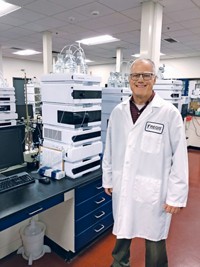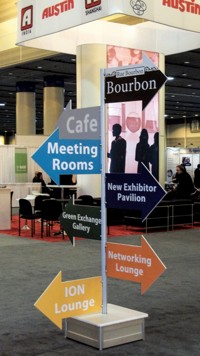Advertisement
Grab your lab coat. Let's get started
Welcome!
Welcome!
Create an account below to get 6 C&EN articles per month, receive newsletters and more - all free.
It seems this is your first time logging in online. Please enter the following information to continue.
As an ACS member you automatically get access to this site. All we need is few more details to create your reading experience.
Not you? Sign in with a different account.
Not you? Sign in with a different account.
ERROR 1
ERROR 1
ERROR 2
ERROR 2
ERROR 2
ERROR 2
ERROR 2
Password and Confirm password must match.
If you have an ACS member number, please enter it here so we can link this account to your membership. (optional)
ERROR 2
ACS values your privacy. By submitting your information, you are gaining access to C&EN and subscribing to our weekly newsletter. We use the information you provide to make your reading experience better, and we will never sell your data to third party members.
Business
Wake-Up Call At ZaCh System
New CEO hopes to get the Italian fine chemicals firm back on its feet
by Rick Mullin
August 19, 2013
| A version of this story appeared in
Volume 91, Issue 33

The year 2007 marked the end of a tumultuous time in pharmaceutical chemicals. Diversified chemical firms were scrambling to exit the sector, and the field was passing to medium-size specialists with long-standing experience in producing active pharmaceutical ingredients (APIs) and other fine chemicals. Among the players vying for position that year was Zambon, a 100-year-old family-owned drug company located near Milan.
Zambon’s first step was to separate its well-established fine chemicals operation from the rest of its business, forming a new company called ZaCh System. It followed up by acquiring plants in La Porte, Texas, and Avrillé, France, from PPG Industries for $65 million. The deal marked Zambon’s first significant foray outside of Italy.
But for ZaCh the tumult continued. “The acquisition of the PPG plants did not work out as expected,” says Roger LaForce, ZaCh’s chief executive officer for one year now. “Quite a lot of money was lost.” Zambon sold the Texas plant to Ampac Fine Chemicals in 2010 “for an apple and an egg,” LaForce says, using a colloquialism popular in his native Switzerland.
Meanwhile, employment at the plant in France was cut in half. Both actions were taken by Paolo Piatesi, a longtime Zambon executive whom the owners brought out of retirement to stabilize ZaCh when the PPG deal put it in a tailspin.

LaForce was hired in June 2012 after eight years as general manager at another Italian fine chemicals firm, Fabbrica Italiana Sintetici (FIS). His charge was straightforward but challenging: Return ZaCh to profitability and strengthen the company’s presence in the global API market.
Many in the fine chemicals industry were surprised to hear that LaForce had left FIS, but the announcement that he would take the reins at ZaCh made sense, given his success at developing FIS. ZaCh seemed a comparable challenge. “The decision was made before I was hired to maintain and relaunch the fine chemicals business at ZaCh,” LaForce says, “and I saw a chance to do a turnaround.”
It is difficult to resist comparing LaForce’s challenges at ZaCh to what he faced at FIS, where during his eight-year tenure sales doubled and the company’s international profile rose significantly, culminating in its acquisition of a Canadian API producer, Delmar Chemicals, in 2012. “But here, we are in a worse situation,” he says of ZaCh. “We are, at the moment, not making money. But we are going back to making money.”
LaForce insists that as a fine chemicals company with a long-standing manufacturing base in Lonigo, Italy, and a solid operation now in France, ZaCh is poised for growth. “The shock or, let’s say, the disturbance to the system was not so much based on having a bad business but on an investment adventure from which we are recovering.”
ZaCh is proceeding with a five-year plan that includes a return to profitability by 2015, LaForce says. The company has divided its activities into three businesses: generic APIs, representing 40% of revenue; custom synthesis, 30% of revenue; and a new “product dossier” business, in which ZaCh develops a generic product and sells the dossier to a generic drug firm, 2% of revenue. Captive production for Zambon accounts for the remaining 28% of ZaCh’s business.
LaForce also hired a business development manager for North America, Sean M. Diver. Diver is a former manufacturing and procurement manager at Merck & Co. with more recent experience in business development at Lonza, Dr. Reddy’s Laboratories, and Cambridge Major Laboratories.
Last year ZaCh’s sales rose 6% to $145 million, LaForce says. He is targeting $250 million for 2017, the end of the five-year plan. The growth drivers, he says, will be custom synthesis and the dossier business.
LaForce notes that the Avrillé site, which is predominantly used for custom synthesis, is already profitable. The generics business in Lonigo, however, has taken a hit because of Chinese and Indian competition for the seizure medicine gabapentin. ZaCh, the largest supplier of the generic API in Europe, sold 500 metric tons of gabapentin last year, but LaForce expects volume to drop 50% this year. Nevertheless, the company is scaling up its overall generics production, LaForce says, targeting the introduction of two APIs per year.
Zambon established a $93 million capital budget for ZaCh to cover the five-year plan. ZaCh is installing a new spray dryer in Avrillé that will add solvent-based capacity to the aqueous system in place now. The company is also installing a midrange-capacity manufacturing plant—complementing its pilot and commercial-scale plants—to better accommodate customers launching new products, LaForce says.
LaForce ticks off a broad menu of technologies at ZaCh, including chiral separations, high- and low-temperature reactions, organometallic chemistry, and an accelerated Grignard technology that ZaCh calls “turbo Grignard.” The company uses continuous microreactor processing in Lonigo and ozonolysis in Avrillé.
And LaForce points to ZaCh’s access to a synchrotron, a particle beam technology related to the cyclotron that the firm uses for crystal and polymorph analysis. “I am always thrilled by it,” he says. “It is used generally for basic science, but instead we can directly use the data from the beam analysis for industrial and commercial purposes. It is like a shortcut from science to industry.”
But technology and capacity are taken for granted in pharmaceutical chemicals, LaForce acknowledges. What matters are the “soft factors,” he says: service and customer relations. Partnerships are also important, LaForce adds, in the product dossier business, for example, where ZaCh works with firms such as Catalent Pharma Solutions, a New Jersey-based contract research organization, to develop generics products.
ZaCh also has research partnerships with the University of Milan studying synthetic routes and with the University of Rouen, in France, studying solid-state API formulation.
The challenge of communicating these capabilities to potential customers in North America falls to Diver, who is based in Doylestown, Pa. “We have a stronger name in Europe and a broader customer base,” he acknowledges. “The customers we do have here are large pharma companies, but certainly the medium-size and emerging pharma market makes sense for us.”
James Bruno, president of Chemical & Pharmaceutical Solutions, a consulting firm in Princeton, N.J., sees LaForce taking on a turnaround assignment similar to the one he completed at FIS. There “he took a standard, run-of-the-mill company and said, ‘I can make it better.’ ” This time, LaForce is involved in a revitalization, Bruno adds. “Ten years ago, ZaCh was a leader in technology,” he says. “He is trying to reestablish that.”
Diver would agree, calling the company’s manufacturing infrastructure and family ownership solid bases for growth. “That family-owned culture is one of our greatest strengths,” he says, noting that family ownership in Italy is not a barrier to global expansion. Diver points to FIS’s relationship with Delmar under LaForce as a template for partnerships at ZaCh.
LaForce plays down the notion that he is ushering in any great change. “It’s more a matter of waking up the potential capabilities that already exist,” he says. Despite the failed 2007 acquisition, LaForce says he wants to motivate company managers to take risks. “When you make an industrial offer for a product that may be on the market in 10 years, you are making a financial bet,” he says. “In order to be profitable, you need a business model, and you need to give people the responsibility to do things well.”





Join the conversation
Contact the reporter
Submit a Letter to the Editor for publication
Engage with us on Twitter